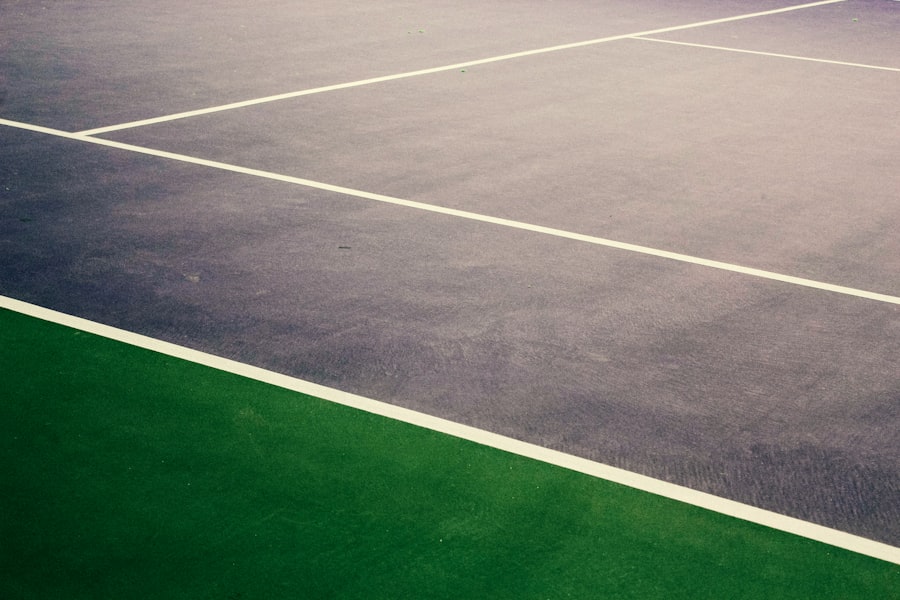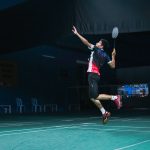Mastering the Art of Badminton: Tips for Success
Description
Badminton is a fast-paced racquet sport that has gained immense popularity worldwide, characterized by its unique blend of agility, strategy, and precision. The game is played with a shuttlecock, which is a feathered projectile that players hit back and forth over a net. The objective is to score points by landing the shuttlecock in the opponent’s court while preventing them from doing the same.
The sport can be played in singles or doubles formats, each requiring different strategies and skills. Understanding the basic rules, scoring system, and court dimensions is essential for anyone looking to engage in badminton, whether casually or competitively. The court itself is rectangular, measuring 13.4 meters long and 6.1 meters wide for doubles play, while singles play narrows the width to 5.18 meters.
The net stands at a height of 1.55 meters at the center and 1.524 meters at the sides. Players must serve from behind the service line, and the shuttlecock must pass over the net and land within the designated boundaries to be considered in play. Scoring in badminton follows a rally point system, where points can be won by either player or team regardless of who served.
Matches are typically played to 21 points, with a player needing to win by at least two points. Understanding these fundamentals lays the groundwork for developing more advanced skills and strategies in badminton.
Key Takeaways
- Badminton is a fast-paced racket sport played with a shuttlecock, and requires agility, speed, and precision.
- Good footwork and movement on the court are essential for success in badminton, and can be improved through drills and practice.
- Effective serving techniques, such as the low serve and flick serve, are crucial for gaining an advantage in a match.
- Mastering different types of shots, including the clear, drop shot, and smash, is important for keeping opponents off balance.
- Agility and speed can be enhanced through specific training exercises and drills, such as ladder drills and agility ladder work.
Improving Footwork and Movement on the Court
Developing a Strong Base
To improve footwork, players should focus on developing a strong base through exercises that enhance agility and coordination. Drills such as ladder exercises, cone drills, and shadow badminton can help players become more nimble on their feet, allowing them to move quickly in any direction.
Mastering Footwork Patterns
Practicing specific footwork patterns can significantly enhance a player’s movement on the court. For instance, mastering the split step—a quick jump that allows players to react swiftly to their opponent’s shot—can provide a significant advantage during rallies.
Incorporating Footwork into Training
Players should also work on lateral movements and backward sprints to ensure they can cover all areas of the court efficiently. Incorporating these techniques into regular training sessions will not only improve footwork but also contribute to overall performance during matches.
Developing Effective Serving Techniques

Serving is one of the most crucial skills in badminton, as it sets the tone for each rally. A well-executed serve can put pressure on the opponent right from the start, while a poor serve can lead to easy points for them. There are several types of serves in badminton, including high serves, low serves, flick serves, and drive serves, each serving a different strategic purpose.
High serves are typically used in singles play to push the opponent to the back of the court, while low serves are more common in doubles play to create opportunities for quick attacks. To develop effective serving techniques, players should focus on their grip, stance, and follow-through. The forehand grip is commonly used for most serves, allowing for better control and power. Practicing serves consistently will help players understand the nuances of each type and how to adapt their serving style based on their opponent’s weaknesses.
Additionally, incorporating variations in speed and angle can make serves more unpredictable, keeping opponents on their toes and increasing the chances of winning points right from the service line.
Mastering Different Types of Shots
| Shot Type | Definition | Importance |
|---|---|---|
| Forehand | A shot played with the racket in a vertical position and the palm of the hand facing the direction of the shot. | Allows for powerful and accurate shots. |
| Backhand | A shot played with the back of the hand facing the direction of the shot. | Essential for covering the other side of the court and maintaining balance. |
| Volley | A shot played before the ball bounces on the court. | Allows for quick and aggressive play at the net. |
| Overhead Smash | A powerful shot played above the head when the ball is high in the air. | Effective for finishing points and putting pressure on opponents. |
In badminton, mastering various types of shots is essential for becoming a well-rounded player capable of adapting to different match situations. The primary shots include clears, drops, smashes, and net shots, each serving distinct tactical purposes. Clears are high shots that push opponents to the back of the court, creating space for offensive plays.
Drops are softer shots that fall just over the net, designed to catch opponents off guard and force them into difficult positions. Smashes are powerful downward shots aimed at winning points outright by overwhelming opponents with speed and force. To execute an effective smash, players must generate significant racket head speed while maintaining proper body positioning.
Practicing these shots regularly will help players develop their technique and timing, allowing them to execute them effectively during matches.
Enhancing Agility and Speed
Agility and speed are paramount in badminton due to the sport’s fast-paced nature. Players must be able to change direction quickly while maintaining balance and control over their movements. To enhance agility, incorporating plyometric exercises such as box jumps, lateral hops, and agility ladder drills into training routines can be highly beneficial.
These exercises not only improve explosive power but also train the body to respond quickly to sudden changes in direction. Speed training is equally important for badminton players. Sprinting drills that focus on short bursts of speed can help players develop quick acceleration on the court.
Interval training—alternating between high-intensity sprints and periods of rest—can also improve cardiovascular fitness while simulating match conditions where quick recovery is essential between rallies. By consistently working on agility and speed through targeted exercises, players can significantly enhance their overall performance during matches.
Strategies for Singles and Doubles Play

Singles Strategies
In singles matches, players focus on controlling the center of the court and using a combination of clears and drops to manipulate their opponent’s positioning. A common strategy is to create openings by alternating between deep shots that push opponents back and short shots that draw them forward.
Doubles Strategies
In doubles play, teamwork becomes crucial as players must communicate effectively and cover their respective areas of the court efficiently. A common strategy involves one player taking charge at the net while the other covers the backcourt; this allows for quick interceptions of incoming shots while maintaining offensive pressure on opponents. Additionally, employing formations such as side-by-side or front-and-back can help teams adapt their strategy based on their opponents’ strengths and weaknesses.
Mental Preparation and Focus
Mental preparation plays a significant role in achieving success in badminton, as it directly impacts a player’s performance during matches. Developing mental resilience involves cultivating focus, confidence, and composure under pressure. Visualization techniques can be particularly effective; players can mentally rehearse their matches by visualizing successful shots and strategies before stepping onto the court.
This practice not only boosts confidence but also helps reduce anxiety associated with competition. Additionally, mindfulness techniques such as deep breathing exercises can aid in maintaining focus during intense rallies or high-stakes moments in matches. By training the mind to stay present and composed, players can make better decisions on the court and respond effectively to challenging situations.
Regularly incorporating mental training into practice routines will help players develop a strong mental game that complements their physical skills.
Fitness and Conditioning for Badminton
Fitness and conditioning are integral components of a successful badminton training regimen. The sport demands a combination of strength, endurance, flexibility, and coordination; therefore, a well-rounded fitness program should address all these aspects. Strength training exercises focusing on core stability, leg strength, and upper body power can enhance overall performance on the court.
Exercises such as squats, lunges, push-ups, and resistance band workouts are excellent choices for building strength relevant to badminton movements. Endurance training is equally important due to the high-intensity nature of matches that often require sustained effort over extended periods. Incorporating aerobic exercises like running or cycling into training routines can improve cardiovascular fitness levels significantly.
Flexibility training through stretching or yoga can enhance range of motion and reduce injury risk by promoting muscle elasticity. By prioritizing fitness and conditioning as part of their training regimen, badminton players can ensure they are physically prepared for the demands of competitive play while maximizing their performance potential on the court.
If you are looking to improve your badminton skills, you may want to check out this article on pic collage editor de fotos. This article may provide some tips and tricks to enhance your game and take it to the next level. Remember, practice makes perfect, so keep working hard on your badminton game!
FAQs
What is badminton?
Badminton is a racquet sport played by either two opposing players (singles) or two opposing pairs (doubles), who take positions on opposite halves of a rectangular court divided by a net.
What equipment is used in badminton?
The primary equipment used in badminton includes a shuttlecock (also known as a birdie), badminton racquets, and a net. Players also typically wear appropriate athletic clothing and non-marking shoes.
What are the basic rules of badminton?
The basic rules of badminton include serving diagonally, scoring points by landing the shuttlecock within the opponent’s court, and winning a match by winning two out of three games.
What are the health benefits of playing badminton?
Playing badminton can provide numerous health benefits, including improved cardiovascular fitness, agility, coordination, and flexibility. It also helps in burning calories and improving overall physical fitness.
What are the different types of badminton shots?
Some of the different types of badminton shots include the clear, drop shot, smash, drive, and the backhand shot. Each shot has its own specific technique and purpose in the game.
What are the different types of badminton tournaments?
There are various types of badminton tournaments, including local, national, and international competitions. The most prestigious international tournaments include the All England Open, BWF World Championships, and the Olympic Games.





